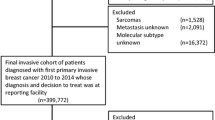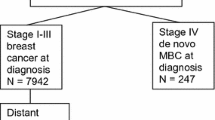Abstract
Purpose
To examine the occurrence and outcomes of de novo metastatic (Stage IV) breast cancer, particularly with respect to tumor HER2 expression.
Methods
We studied all 6,268 de novo metastatic breast cancer cases diagnosed from 1 January 2005 to 31 December 2011 and reported to the California Cancer Registry. Molecular subtypes were classified according to HER2 and hormone receptor (HR, including estrogen and/or progesterone receptor) expression. Multivariable logistic regression was used to estimate odds ratios (ORs) and 95 % confidence intervals (CIs) of Stage IV versus Stage I–III breast cancer; Cox proportional hazards regression was used to assess relative hazard (RH) of mortality.
Results
Five percent of invasive breast cancer was metastatic at diagnosis. Compared to patients with earlier stage disease, patients with de novo metastatic disease were significantly more likely to have HER2+ tumors (HR+/HER2+: OR 1.29, 95 % CI 1.17–1.42; HR−/HER2+: OR 1.40, 95 %CI 1.25–1.57, vs. HR+/HER2−). Median survival improved over time, but varied substantially across race/ethnicity (Asians: 34 months; African Americans: 6 months), neighborhood socioeconomic status (SES) (highest: 34 months, lowest: 20 months), and molecular subtype (HR+/HER2+: 45 months; triple negative: 12 months). In a multivariable model, triple negative (RH 2.85, 95 % CI 2.50–3.24) and HR−/HER2+ (RH 1.60, 95 % CI 1.37–1.87) had worse, while HR+/HER2+ had similar, risk of all-cause death compared to HR+/HER2− breast cancer.
Conclusions
De novo metastatic breast cancer was more likely to be HER2+. Among metastatic tumors, those that were HER2+ had better survival than other subtypes.


Similar content being viewed by others

References
American Cancer Society (2013) Breast cancer facts and figures 2013–2014. American Cancer Society, Inc., Atlanta
Commission on Cancer—National Cancer Database (2007) Benchmark Reports, V 8.0-August 20, 2007—STAGE of Breast Cancer Diagnosed in 2004: Commission on Cancer—National Cancer Database (NCDB)
Hortobagyi GN (1998) Treatment of breast cancer. N Engl J Med 339:974–984
Bernard-Marty C, Cardoso F, Piccart MJ (2004) Facts and controversies in systemic treatment of metastatic breast cancer. Oncologist 9:617–632
Lannin DR, Mathews HF, Mitchell J, Swanson MS, Swanson FH, Edwards MS (1998) Influence of socioeconomic and cultural factors on racial differences in late-stage presentation of breast cancer. JAMA 279:1801–1807
Lee-Feldstein A, Feldstein PJ, Buchmueller T, Katterhagen G (2000) The relationship of HMOs, health insurance, and delivery systems to breast cancer outcomes. Med Care 38:705–718
Clegg LX, Reichman ME, Miller BA et al (2009) Impact of socioeconomic status on cancer incidence and stage at diagnosis: selected findings from the surveillance, epidemiology, and end results: National Longitudinal Mortality Study. Cancer Causes Control 20:417–435
Breen N, Figueroa JB (1996) Stage of breast and cervical cancer diagnosis in disadvantaged neighborhoods: a prevention policy perspective. Am J Prev Med 12:319–326
Barry J, Breen N (2005) The importance of place of residence in predicting late-stage diagnosis of breast or cervical cancer. Health Place 11:15–29
Eroles P, Bosch A, Perez-Fidalgo JA, Lluch A (2012) Molecular biology in breast cancer: intrinsic subtypes and signaling pathways. Cancer Treat Rev 38:698–707
Dawood S, Broglio K, Buzdar AU, Hortobagyi GN, Giordano SH (2010) Prognosis of women with metastatic breast cancer by HER2 status and trastuzumab treatment: an institutional-based review. J Clin Oncol 28:92–98
Carey LA, Perou CM, Livasy CA et al (2006) Race, breast cancer subtypes, and survival in the Carolina Breast Cancer Study. JAMA 295:2492–2502
Perou CM, Sorlie T, Eisen MB et al (2000) Molecular portraits of human breast tumours. Nature 406:747–752
Sotiriou C, Wirapati P, Loi S et al (2006) Gene expression profiling in breast cancer: understanding the molecular basis of histologic grade to improve prognosis. J Natl Cancer Inst 98:262–272
Ramakrishna N, Temin S, Chandarlapaty S et al (2014) Recommendations on disease management for patients with advanced human epidermal growth factor receptor 2-positive breast cancer and brain metastases: American Society of Clinical Oncology clinical practice guideline. J Clin Oncol 32:2100–2108
Giordano SH, Temin S, Kirshner JJ et al (2014) Systemic therapy for patients with advanced human epidermal growth factor receptor 2-positive breast cancer: American Society of Clinical Oncology clinical practice guideline. J Clin Oncol 32:2078–2099
Lund MJ, Trivers KF, Porter PL et al (2009) Race and triple negative threats to breast cancer survival: a population-based study in Atlanta, GA. Breast Cancer Res Treat 113:357–370
O’Brien KM, Cole SR, Tse CK et al (2010) Intrinsic breast tumor subtypes, race, and long-term survival in the Carolina Breast Cancer Study. Clin Cancer Res 16:6100–6110
Yost K, Perkins C, Cohen R, Morris C, Wright W (2001) Socioeconomic status and breast cancer incidence in California for different race/ethnic groups. Cancer Causes Control 12:703–711
Yang J, Schupp CW, Harrati A, Clarke C, Keegan THM, Gomez SL (2014) Developing an area-based socioeconomic measure from American Community Survey data. Cancer Prevention Institute of California, Fremont
Bauer KR, Brown M, Cress RD, Parise CA, Caggiano V (2007) Descriptive analysis of estrogen receptor (ER)-negative, progesterone receptor (PR)-negative, and HER2-negative invasive breast cancer, the so-called triple-negative phenotype: a population-based study from the California cancer Registry. Cancer 109:1721–1728
Bernstein L, Lacey JV Jr (2011) Receptors, associations, and risk factor differences by breast cancer subtypes: positive or negative? J Natl Cancer Inst 103:451–453
Wolff AC, Hammond ME, Schwartz JN et al (2007) American Society of Clinical Oncology/College of American Pathologists guideline recommendations for human epidermal growth factor receptor 2 testing in breast cancer. J Clin Oncol 25:118–145
Surveillance, Epidemiology, and End Results (SEER) Program (2013) SEER*Stat database: incidence—SEER 18 Regs research Data + Hurricane Katrina Impacted Louisiana Cases, Nov 2013 Sub (1973–2011 varying)—Linked To County Attributes—Total U.S., 1969–2012 Counties, National Cancer Institute, DCCPS, Surveillance Research Program, Surveillance Systems Branch, released April 2014 (updated 5/7/2014), based on the November 2013 submission (www.seer.cancer.gov)
Leyland-Jones B (2009) Human epidermal growth factor receptor 2-positive breast cancer and central nervous system metastases. J Clin Oncol 27:5278–5286
Pestalozzi BC, Zahrieh D, Price KN et al (2006) Identifying breast cancer patients at risk for central nervous system (CNS) metastases in trials of the International Breast Cancer Study Group (IBCSG). Ann Oncol 17:935–944
Gabos Z, Sinha R, Hanson J et al (2006) Prognostic significance of human epidermal growth factor receptor positivity for the development of brain metastasis after newly diagnosed breast cancer. J Clin Oncol 24:5658–5663
Welch HG, Gorski DH, Albertsen PC (2015) Trends in metastatic breast and prostate cancer-lessons in cancer dynamics. N Engl J Med 373:1685–1687
Khadakban D, Gorasia-Khadakban T, Vijaykumar DK, Pavithran K, Anupama R (2013) Factors associated with better survival after surgery in metastatic breast cancer patients. Indian J Surg Oncol 4:52–58
Bradley CJ, Given CW, Roberts C (2002) Race, socioeconomic status, and breast cancer treatment and survival. J Natl Cancer Inst 94:490–496
Zimmermann C, Swami N, Krzyzanowska M et al (2014) Early palliative care for patients with advanced cancer: a cluster-randomised controlled trial. Lancet 383:1721–1730
Vaz-Luis I, Lin NU, Keating NL et al (2015) Racial differences in outcomes for patients with metastatic breast cancer by disease subtype. Breast Cancer Res Treat 151:697–707
Tao L, Gomez SL, Keegan TH, Kurian AW, Clarke CA (2015) Breast cancer mortality in African-American and non-hispanic white women by molecular subtype and stage at diagnosis: a Population-Based Study. Cancer Epidemiol Biomark Prev 24:1039–1045
Baquet CR, Commiskey P (2000) Socioeconomic factors and breast carcinoma in multicultural women. Cancer 88:1256–1264
Schwartz KL, Crossley-May H, Vigneau FD, Brown K, Banerjee M (2003) Race, socioeconomic status and stage at diagnosis for five common malignancies. Cancer Causes Control 14:761–766
Newman LA (2005) Breast cancer in African-American women. Oncologist 10:1–14
Mandelblatt JS, Yabroff KR, Kerner JF (1999) Equitable access to cancer services: a review of barriers to quality care. Cancer 86:2378–2390
Richards MA, Westcombe AM, Love SB, Littlejohns P, Ramirez AJ (1999) Influence of delay on survival in patients with breast cancer: a systematic review. Lancet 353:1119–1126
Aizer AA, Chen MH, McCarthy EP et al (2013) Marital status and survival in patients with cancer. J Clin Oncol 31:3869–3876
Cohen SD, Sharma T, Acquaviva K, Peterson RA, Patel SS, Kimmel PL (2007) Social support and chronic kidney disease: an update. Adv Chronic Kidney Dis 14:335–344
Goldzweig G, Andritsch E, Hubert A et al (2010) Psychological distress among male patients and male spouses: what do oncologists need to know? Ann Oncol 21:877–883
Carlson RW, Allred DC, Anderson BO et al (2012) Metastatic breast cancer, version 1.2012: featured updates to the NCCN guidelines. J Natl Compr Canc Netw 10:821–829
Rapiti E, Verkooijen HM, Vlastos G et al (2006) Complete excision of primary breast tumor improves survival of patients with metastatic breast cancer at diagnosis. J Clin Oncol 24:2743–2749
Ruiterkamp J, Voogd AC, Bosscha K, Tjan-Heijnen VC, Ernst MF (2010) Impact of breast surgery on survival in patients with distant metastases at initial presentation: a systematic review of the literature. Breast Cancer Res Treat 120:9–16
Khan SA (2007) Does resection of an intact breast primary improve survival in metastatic breast cancer? Oncology (Williston Park). 21: 924-31; discussion 31-2, 34, 42, passim
Gnerlich J, Jeffe DB, Deshpande AD, Beers C, Zander C, Margenthaler JA (2007) Surgical removal of the primary tumor increases overall survival in patients with metastatic breast cancer: analysis of the 1988–2003 SEER data. Ann Surg Oncol 14:2187–2194
Cady B, Nathan NR, Michaelson JS, Golshan M, Smith BL (2008) Matched pair analyses of stage IV breast cancer with or without resection of primary breast site. Ann Surg Oncol 15:3384–3395
(2011) New therapies for metastatic disease addressed in updated NCCN Guidelines for breast cancer. J Natl Compr Canc Netw 9: xxxii–xxxiii
Slamon D, Pegram M (2001) Rationale for trastuzumab (Herceptin) in adjuvant breast cancer trials. Semin Oncol 28:13–19
Baselga J, Cortes J, Kim SB et al (2012) Pertuzumab plus trastuzumab plus docetaxel for metastatic breast cancer. N Engl J Med 366:109–119
Verma S, Joy AA, Rayson D et al (2013) HER story: the next chapter in HER-2-directed therapy for advanced breast cancer. Oncologist 18:1153–1166
Geyer CE, Forster J, Lindquist D et al (2006) Lapatinib plus capecitabine for HER2-positive advanced breast cancer. N Engl J Med 355:2733–2743
Acknowledgments
The collection of cancer incidence data used in this study was supported by the California Department of Public Health as part of the statewide cancer reporting program mandated by California Health and Safety Code Section 103885; the National Cancer Institute’s Surveillance, Epidemiology, and End Results Program under contract HHSN2612010000140C awarded to the Cancer Prevention Institute of California, contract HHSN261201000035C awarded to the University of Southern California, and contract HHSN261201000034C awarded to the Public Health Institute; and the Centers for Disease Control and Prevention’s National Program of Cancer Registries, under agreement #1U58 DP000807-01 awarded to the Public Health Institute. The ideas and opinions expressed herein are those of the authors and endorsement by the State of California, Department of Health Services, the National Cancer Institute, and the Centers for Disease Control and Prevention or their contractors and subcontractors are not intended nor should be inferred.
Financial support
This project was funded by Genentech which develops products that target cancer entities described in this paper. The funding came to the Cancer Prevention Institute of California, and the terms of this arrangement were reviewed and approved by the Cancer Prevention Institute of California in accordance with its policy regarding objectivity in research.
Author information
Authors and Affiliations
Corresponding author
Ethics declarations
Conflict of interest
No authors declare other financial conflict of interest.
Rights and permissions
About this article
Cite this article
Tao, L., Chu, L., Wang, L.I. et al. Occurrence and outcome of de novo metastatic breast cancer by subtype in a large, diverse population. Cancer Causes Control 27, 1127–1138 (2016). https://doi.org/10.1007/s10552-016-0791-9
Received:
Accepted:
Published:
Issue Date:
DOI: https://doi.org/10.1007/s10552-016-0791-9



